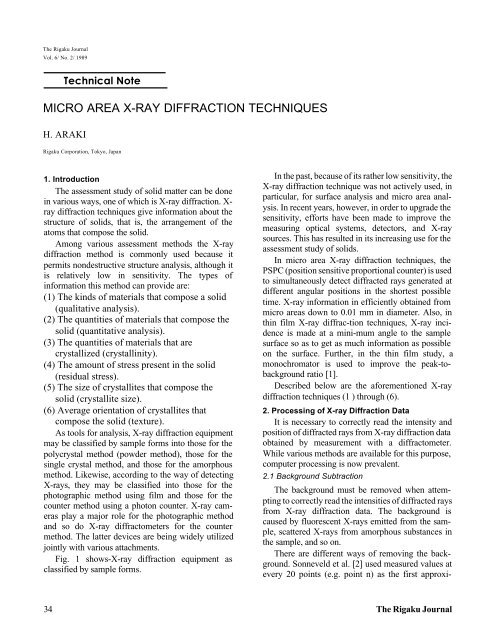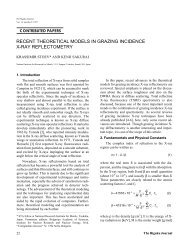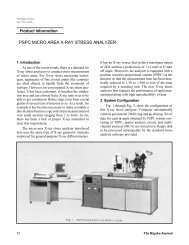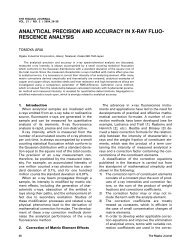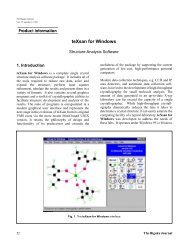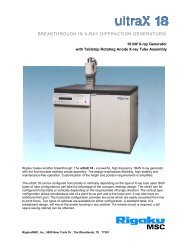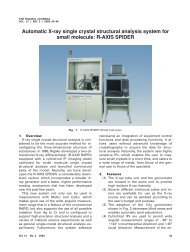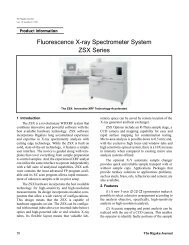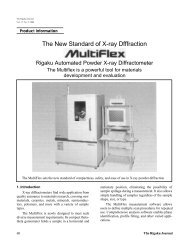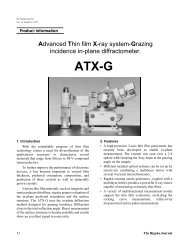MICRO AREA X-RAY DIFFRACTION TECHNIQUES - Rigaku
MICRO AREA X-RAY DIFFRACTION TECHNIQUES - Rigaku
MICRO AREA X-RAY DIFFRACTION TECHNIQUES - Rigaku
You also want an ePaper? Increase the reach of your titles
YUMPU automatically turns print PDFs into web optimized ePapers that Google loves.
The <strong>Rigaku</strong> Journal<br />
Vol. 6/ No. 2/ 1989<br />
Technical Note<br />
<strong>MICRO</strong> <strong>AREA</strong> X-<strong>RAY</strong> <strong>DIFFRACTION</strong> <strong>TECHNIQUES</strong><br />
H. ARAKI<br />
<strong>Rigaku</strong> Corporation, Tokyo, Japan<br />
1. Introduction<br />
The assessment study of solid matter can be done<br />
in various ways, one of which is X-ray diffraction. X-<br />
ray diffraction techniques give information about the<br />
structure of solids, that is, the arrangement of the<br />
atoms that compose the solid.<br />
Among various assessment methods the X-ray<br />
diffraction method is commonly used because it<br />
permits nondestructive structure analysis, although it<br />
is relatively low in sensitivity. The types of<br />
information this method can provide are:<br />
(1) The kinds of materials that compose a solid<br />
(qualitative analysis).<br />
(2) The quantities of materials that compose the<br />
solid (quantitative analysis).<br />
(3) The quantities of materials that are<br />
crystallized (crystallinity).<br />
(4) The amount of stress present in the solid<br />
(residual stress).<br />
(5) The size of crystallites that compose the<br />
solid (crystallite size).<br />
(6) Average orientation of crystallites that<br />
compose the solid (texture).<br />
As tools for analysis, X-ray diffraction equipment<br />
may be classified by sample forms into those for the<br />
polycrystal method (powder method), those for the<br />
single crystal method, and those for the amorphous<br />
method. Likewise, according to the way of detecting<br />
X-rays, they may be classified into those for the<br />
photographic method using film and those for the<br />
counter method using a photon counter. X-ray cameras<br />
play a major role for the photographic method<br />
and so do X-ray diffractometers for the counter<br />
method. The latter devices are being widely utilized<br />
jointly with various attachments.<br />
Fig. 1 shows-X-ray diffraction equipment as<br />
classified by sample forms.<br />
In the past, because of its rather low sensitivity, the<br />
X-ray diffraction technique was not actively used, in<br />
particular, for surface analysis and micro area analysis.<br />
In recent years, however, in order to upgrade the<br />
sensitivity, efforts have been made to improve the<br />
measuring optical systems, detectors, and X-ray<br />
sources. This has resulted in its increasing use for the<br />
assessment study of solids.<br />
In micro area X-ray diffraction techniques, the<br />
PSPC (position sensitive proportional counter) is used<br />
to simultaneously detect diffracted rays generated at<br />
different angular positions in the shortest possible<br />
time. X-ray information in efficiently obtained from<br />
micro areas down to 0.01 mm in diameter. Also, in<br />
thin film X-ray diffraction techniques, X-ray incidence<br />
is made at a minimum angle to the sample<br />
surface so as to get as much information as possible<br />
on the surface. Further, in the thin film study, a<br />
monochromator is used to improve the peak-tobackground<br />
ratio [1].<br />
Described below are the aforementioned X-ray<br />
diffraction techniques (1 ) through (6).<br />
2. Processing of X-ray Diffraction Data<br />
It is necessary to correctly read the intensity and<br />
position of diffracted rays from X-ray diffraction data<br />
obtained by measurement with a diffractometer.<br />
While various methods are available for this purpose,<br />
computer processing is now prevalent.<br />
2.1 Background Subtraction<br />
The background must be removed when attempting<br />
to correctly read the intensities of diffracted rays<br />
from X-ray diffraction data. The background is<br />
caused by fluorescent X-rays emitted from the sample,<br />
scattered X-rays from amorphous substances in<br />
the sample, and so on.<br />
There are different ways of removing the background.<br />
Sonneveld et al. [2] used measured values at<br />
every 20 points (e.g. point n) as the first approxi-<br />
34 The <strong>Rigaku</strong> Journal
Vol. 6 No. 2 1989 35
mation of the background. But in view of a likelihood<br />
that some of the selected points fall on diffraction<br />
lines, they conceived sample P i (i= 2, 3, . . ., n - 1 ) at<br />
point n - 2 by removing both ends in order to achieve a<br />
better approximation. In this case, calculation of (m i-1<br />
+P i+1 )/2 is to be made, and if Pi > m i , then P i should be<br />
replaced with m i .<br />
A smooth curve can be obtained by repeating the<br />
above procedure several times and sequentially<br />
connecting each point. This curve is regarded as the<br />
background and is to be subtracted from the<br />
measurement data. If the background changes<br />
forming a curve as shown in Fig. 2(b) instead of<br />
changing almost linearly in terms of 2θ, then P i >m i +C<br />
may be used to replace the formula P i > m i .<br />
There is R. P. Goehner's [3] method as another<br />
method along with other pertinent ones which have<br />
been devised according to the memory size and speed<br />
of computers to be used.<br />
2.2 Detection of Peak Position and Its Measurement<br />
Various methods are available for peak position<br />
determination as well. What is frequently used is one<br />
by means of a quadratic differential curve of the<br />
measurement data [4], [5], [6]. (See Fig. 3.) The<br />
quadratic differential method is advantageous in that<br />
it allows peak detection even in the case of raw data as<br />
well as in the case of a peak overlapped with another<br />
peak at its shoulder, thus making its detection difficult<br />
by the linear differential method.<br />
Fig. 2 Background determination. (a) When background<br />
is roughly a straight line. (b) When background has some<br />
curvature.<br />
Fig. 3 Peak detection and positional determination with<br />
linear and quadratic curves.<br />
Fig. 4 Example of qualitative analysis result.<br />
36 The <strong>Rigaku</strong> Journal
3. General X-ray Diffraction Techniques<br />
Fig. 5 Difference in calibration curve due to absorption<br />
coefficient.<br />
3.1 Qualitative Analysis<br />
This analytical procedure is the so-called searchmatch<br />
of X-ray diffraction data, such that the diffraction<br />
pattern of an unknown sample is measured and is<br />
compared with already known standard patterns<br />
(JCPDS cards) to obtain an identification.<br />
When the unknown sample consists of a single<br />
material, its qualitative analysis is rather simple.<br />
When it is a mixture, on the other hand, the analysis<br />
requires high-level skills because of the many diffraction<br />
present. A variety of combinations of standard<br />
patterns should be taken into account. To cope with<br />
the situation, an attempt to carry out search-match<br />
with a computer was initiated in the 1960s, and improvements<br />
have been made year after year. The presentday<br />
search-match has gone so far as to include a<br />
search of the complete JCPDS files, comprising over<br />
48,000 patterns.<br />
3.2 Quantitative Analysis<br />
This procedure estimates the quantity of the<br />
analyte material by taking advantage of the fact that<br />
the peak heights in an X-ray diffraction pattern are<br />
proportional to the quantities of materials that compose<br />
a solid.<br />
In quantitative analysis by X-ray diffraction, the<br />
mean mass absorption coefficient depends on the difference<br />
in the quantity ratio of material, resulting in a<br />
difference in the diffracted ray intensity. It is important,<br />
therefore, to correct for absorption due to the<br />
material. Quantitative analysis techniques are classified<br />
according to differences in the absorption correction.<br />
Quantitative analysis may be made in two ways;<br />
one is the internal standard method designed to mix a<br />
known quantity of material into an unknown sample,<br />
and the other is the external standard method designed<br />
for separate measurement without mixing. Although<br />
the external standard method is preferable for<br />
quantitative analysis, errors are liable to occur in this<br />
method. For this reason, the internal standard method<br />
is more often used.<br />
3.3 Crystallinity<br />
In X-ray diffraction data a pattern due to a crystalline<br />
material and a pattern due to an amorphous<br />
material may overlap with each other. They differ as<br />
shown in Fig. 6.<br />
While various methods are available for the<br />
determination of crystallinity, they are basically the<br />
same. That is, they employ a way of examining the<br />
degree of crystallinity from a ratio between the<br />
Fig. 6 When crystalline material and amorphous material area mixed together.<br />
Vol. 6 No. 2 1989 37
Fig. 7 Uniform distortion and nonuniform distortion.<br />
Fig. 8 Stress and lattice interplanar spacing.<br />
pattern area of the crystalline material and that of the<br />
amorphous material. There is such a case, however, as<br />
with graphite, for instance, where the position of its<br />
diffraction line will vary depending on the degree of<br />
crystalline properties. This is also referred to as<br />
crystallinity.<br />
3.4 Residual Stress<br />
When force is applied solid matter within its<br />
elastic limit, it will be deformed in proportion to the<br />
magnitude of the force. In other words, the crystal<br />
lattice interplanar spacing (d-value) of the material<br />
will change. This distortion is uniform and it should<br />
be distinguished from nonuniform distortion referred<br />
to in Fig. 7.<br />
When changes in the diffraction angle (2θ) are<br />
examined by varying the angle ψ formed by the<br />
normal to the sample plane and that to the lattice<br />
plane, the stress value can be obtained by using the<br />
following equation.<br />
E<br />
π ∂( 2θ)<br />
σ = − ⋅cot<br />
θ<br />
0<br />
⋅ ⋅<br />
2<br />
2 1+<br />
ν 180 ∂ sin φ<br />
( )<br />
( )<br />
= K ⋅<br />
∂<br />
∂<br />
( 2θ)<br />
( sin 2 φ)<br />
where<br />
σ: Stress (kg/mm 2 )<br />
E: Young's module (kg/mm 2 )<br />
ν: Poisson's ratio<br />
θ 0 : Standard Bragg angle<br />
K: Constant determined by material and measurement<br />
wavelength (called a stress constant)<br />
The optical system of the stress measuring system<br />
should be selected according to the shape of the object<br />
for measurement and the stress measuring direction.<br />
3.5 Crystallite Size<br />
The peak width in an X-ray diffraction pattern is<br />
related to the size of crystallites that compose the<br />
material.<br />
Besides minuteness of the crystallite, nonuniform<br />
distortion of the crystallite (Fig. 7) is another factor<br />
that causes broadening of the peak width. Accordingly<br />
the size of the average crystallite can be determined<br />
by measuring the peak width. Scherrer's equation and<br />
Hall's equation are often used for calculations of the<br />
crystallite size.<br />
(Method by Scherrer)<br />
K ⋅λ<br />
Dhkl =<br />
βcosθ<br />
where<br />
λ: X-ray wavelength for measurement (Å)<br />
β: Breadth of diffracted rays due to the crystallite<br />
size (rad)<br />
θ: Bragg angle of diffracted rays<br />
K: Constant (which differs depending on β and<br />
D constants)<br />
(Method by Hall)<br />
λ<br />
β = β1 + β2 = + 2ηtanθ<br />
ε cosθ<br />
βcosθ<br />
sinθ<br />
1<br />
∴ = 2η<br />
+<br />
λ λ ε<br />
where<br />
β 1 : Integral width of the breadth of diffracted rays<br />
due to the crystallite size (rad)<br />
β 2 : Integral width of nonuniform distortion η, the<br />
relation with the nonuniform distortion is: β 1 = 2<br />
tan θ<br />
ε: Crystallite size (rad)<br />
38 The <strong>Rigaku</strong> Journal
The gradient of a straight line obtained by plotting<br />
βcosθ/λ and sinθ/λ on the Y-axis and X-axis<br />
respectively, is 2η. The point of intersection with the<br />
Y-axis is 1/ε. From this, calculation can be made by<br />
separating the ununiform distortion η and the crystallite<br />
size from each other.<br />
3.6 Texture<br />
When the crystal orientation of matter that<br />
composes a solid is random, the resultant Debye rings<br />
will be uniform, as shown in Fig. 11 (a), (b), (c). If, on<br />
the other hand, the crystal orientation is in a particular<br />
direction, an arc shape will result instead of a ring, as<br />
shown in Fig. 11 (d). Such a state is referred to as<br />
preferred orientation.<br />
Sometimes there are cases in which preferred<br />
orientation is specifically given to utilize texture in<br />
order to improve the characteristics of solid materials.<br />
The device to measure the state of this texture is a pole<br />
figure diffractometer attachment.<br />
Fig. 9 Example of residual stress calculation result.<br />
RESULTS OF STRESS ANALYSIS<br />
PEAK POSITION : CENTER OF FWHM<br />
STRESS = -0.36 kg/mm/mm<br />
SIGMA RELIABILITY = +-0.04 kg/mm/mm<br />
4. Assessment of Materials by X-Ray Diffraction<br />
Techniques<br />
The aforementioned items 3.1 through 3.6 serve as<br />
basic assessment methods to examine the state and<br />
quality of solid matter. By way of example, one of the<br />
methods used for analysis of the mechanical behaviors<br />
of materials is shown in Fig. 13.<br />
5. Other X-ray Diffraction Techniques for Material<br />
Assessment<br />
The above descriptions have been made centered<br />
on bulk analysis. In general X-ray diffraction<br />
techniques there are certain systems in which the X-<br />
Fig. 10 Particle size and crystallite size.<br />
Fig. 11 Observation of Debye rings in polycrystals: α-Fe (211).<br />
Vol. 6 No. 2 1989 39
Fig. 12 Measurement example with a pole figure attachment.<br />
Fig. 13 Relations of material information and X-ray diffraction techniques.<br />
ray optics, detector and X-ray source are specifically<br />
deisgned for particular applications, such as:<br />
• Thin film X-ray diffraction method [1]<br />
• X-ray surface diffraction method [7]<br />
• Cone scanning type microdiffractometer<br />
• Curved PSPC type microdiffractometer (PSPC/<br />
MDG)<br />
• Small angle scattering measurement method<br />
etc.<br />
These methods are aimed at surface analysis,<br />
micro area analysis and the like. In any case the<br />
existence of preferred orientation must be taken into<br />
account.<br />
Because the number of crystallites that contribute<br />
to diffraction in lessened in the case of micro area X-<br />
ray diffraction techniques, this may cause discontinuous<br />
Debye rings. For the purpose of getting a<br />
measurement result with high reproducibility by<br />
eliminating this drawback, rotation or oscillation is<br />
applied to the sample during measurement. Three<br />
axes ω, χ and θ are available as the axis of these<br />
movements, and they can be run independently or<br />
simultaneously to perform the desired rotation or<br />
oscillation.<br />
The small angle scattering measurement method<br />
deals with diffuse scattering caused in the vicinity of<br />
40 The <strong>Rigaku</strong> Journal
the incident X-ray direction as well as Bragg<br />
reflections in case of exceedingly large lattice<br />
interplanar spacing. It deals also with a phenomenon<br />
that diffraction due to long periodicity is observed<br />
when the crystalline properties and the amorphous<br />
properties are arranged periodically in fiber samples.<br />
These are utilized for particle size measurement, longperiodicity<br />
measurement, and so on.<br />
6. Conclusion<br />
In recent years, higher-intensity X-ray sources<br />
have become available, such as synchrotron radiation<br />
X-rays from an electron storage ring and X-rays from<br />
a high-power rotating anode X-ray generator.<br />
Moreover, the improvement and progress in<br />
measurement methods now make it possible to<br />
conduct structure analysis of micro area objects for<br />
measurement under various conditions by X-ray<br />
diffraction techniques.<br />
Fig. 14 Measurement example with a thin film attachment.<br />
Fig 16. .Measurement example with PSPC/MDG.<br />
Fig. 15 Measurement example of a rock flake.<br />
Fig 17. Sample moving axes in curved PSPC/MDG.<br />
Vol. 6 No. 2 1989 41
Fig. 18 Effect of 3-axis oscillation<br />
References<br />
[ 1 ] Kobayashi and Yoshimatsu: Progress of X-Ray Analysis<br />
VII, Kagaku Gijutsu-sha (1975), 49.<br />
[ 2 ] E. J. Sonnevied and J. W. Vieser: L. Appl. Cryst., 8<br />
(1975), 1 .<br />
[ 3 ] R. P. Goehner: Anal. Chem., 50 (1978), 1223.<br />
[ 4 ] A. Savitzky and M. J. E. Goley: Anal. Chem., 36 (1964),<br />
1927.<br />
[ 5 ] M. A. Mariscotti: Nuclear Instruments and Methods, 50<br />
(1967), 309.<br />
[ 6 ] W. N. Schreiner and R. Jenkins: Adv. X-ray Analysis, 23<br />
(1980), 287,<br />
[ 7 ] Kikuta: J. of The Crystallographic Society of Japan, 29<br />
(1987), 44.<br />
42 The <strong>Rigaku</strong> Journal


